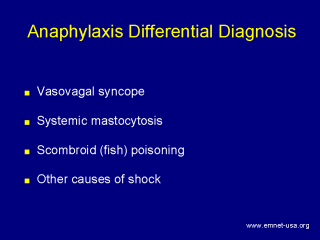 |
The diagnosis of
anaphylaxis can be very easy or very difficult depending on the clinical
manifestations and situation. Acute syncope and hypotension can be due to
vasovagal syncope, especially in a medical setting. It may be distinguished
by bradycardia (unusual in the face of hypotension) and recovery with
recumbency. In a small percentage of cases, bradycardia may accompany
anaphylaxis. All other causes of shock must be considered in the context of
the clinical setting and the presenting signs and symptoms (hypovolemic,
cardiogenic, toxic). The presence of generalized urticaria along with the
other signs may facilitate the diagnosis and treatment, but does not clarify
the cause. Non-allergic causes include systemic mastocytosis (onset can be
in childhood or as an adult; manifestations can be quite variable) and
scombroid fish poisoning which is due to high levels of histamine in poorly
preserved fish. Although other foods can contain histamine and other
vasoactive amines, these limited quantities cause symptoms usually not as
severe as anaphylaxis. |
